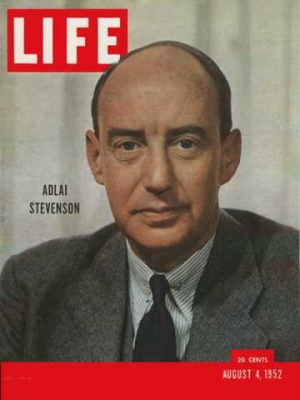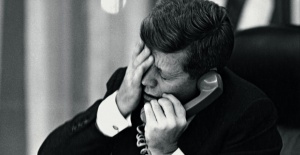Difference between revisions of "Adlai Stevenson"
m |
(sp) |
||
| (2 intermediate revisions by 2 users not shown) | |||
| Line 2: | Line 2: | ||
|constitutes=diplomat, politician | |constitutes=diplomat, politician | ||
|wikipedia=https://en.wikipedia.org/wiki/Adlai_Stevenson_II | |wikipedia=https://en.wikipedia.org/wiki/Adlai_Stevenson_II | ||
| − | | | + | |spartacus=http://spartacus-educational.com/USAstevensonA.htm |
| − | | | + | |image=Adlai Stevenson.jpg |
|spouses=Ellen Borden | |spouses=Ellen Borden | ||
|alma_mater=Princeton University, Northwestern University | |alma_mater=Princeton University, Northwestern University | ||
| Line 23: | Line 23: | ||
}} | }} | ||
}} | }} | ||
| − | '''Adlai Stevenson''' (5 February 1900 – 14 July 1965) was an American politician and diplomat, noted for his intellectual demeanor, eloquent public speaking, and promotion of progressive causes in the [[Democratic Party]]. | + | '''Adlai Stevenson''' (5 February 1900 – 14 July 1965) was an American politician and diplomat, noted for his intellectual demeanor, eloquent public speaking, and promotion of progressive causes in the [[Democratic Party]]. From 1949 to 1953 he served as the 31st Governor of Illinois. |
| − | Stevenson was defeated in a landslide by Republican [[Dwight D. Eisenhower]] | + | ==Presidential nominee== |
| + | Adlai Stevenson received the Democratic Party's nomination for president in 1952 US presidential election, even though he had not campaigned in the primaries. He was defeated in a landslide by Republican [[Dwight D. Eisenhower]]. In 1956 he was again the Democratic presidential nominee against Eisenhower, but was defeated in an even greater landslide. After the 1956 campaign, Stevenson formed a legal firm with [[W. Willard Wirtz]] "that strictly abstained from politics" and whose clients included the [[De Beers]] diamond merchant [[Maurice Tempelsman]].<ref>John Frederick Martin, ''Historically Speaking'' (2013) 14#4 p4 ''[http://muse.jhu.edu/journals/historically_speaking/v014/14.4.martin.html "The Trappings of Democracy"]''</ref> | ||
| − | + | ===Third time unlucky=== | |
| + | Stevenson sought the Democratic presidential nomination for a third time in the election of 1960, but was defeated by Senator [[John F. Kennedy]] of Massachusetts. | ||
| + | |||
| + | ==US Ambassador to the UN== | ||
| + | Upon his inauguration on 20 January 1961, [[President Kennedy]] appointed Adlai Stevenson the [[United States Ambassador to the United Nations]] in New York. | ||
| + | [[image:Kennedy_phone_call.jpg|300px|thumbnail|left|13 February 1961: [[President Kennedy]] hears of Congolese PM [[Patrice Lumumba]]'s murder from UN Ambassador Adlai Stevenson]] | ||
| + | Three days earlier, in a coup allegedly engineered by Maurice Tempelsman with the connivance of the [[CIA]] and [[MI6]], Congolese Prime Minister [[Patrice Lumumba]] had been murdered in Katanga province. [[James DiEugenio]] noted: "The information about his death was kept from President Kennedy for almost a month. He did not learn about Lumumba's murder until February 13th. He learned of it on a phone call with UN Ambassador Adlai Stevenson. White House photographer Jacques Lowe captured the moment in a crystalline photograph."<ref>''[[Document:Hammarskjold and Kennedy vs. The Power Elite]]''</ref> | ||
| + | |||
| + | |||
| + | Stevenson remained ''en poste'' at the UN until he died on 14 July 1965, in [[London]] after suffering a heart attack. | ||
{{SMWDocs}} | {{SMWDocs}} | ||
==References== | ==References== | ||
{{reflist}} | {{reflist}} | ||
{{Stub}} | {{Stub}} | ||
Revision as of 01:12, 7 October 2016
(diplomat, politician) | |
|---|---|
 | |
| Born | Adlai Ewing Stevenson II 1900-02-05 Los Angeles, United States |
| Died | 1965-07-14 (Age 65) London, England, United Kingdom |
| Alma mater | Princeton University, Northwestern University |
| Religion | Unitarian Universalist |
| Spouse | Ellen Borden |
| Member of | Council on Foreign Relations/Historical Members, Phi Delta Theta |
| Party | Democratic |
Adlai Stevenson (5 February 1900 – 14 July 1965) was an American politician and diplomat, noted for his intellectual demeanor, eloquent public speaking, and promotion of progressive causes in the Democratic Party. From 1949 to 1953 he served as the 31st Governor of Illinois.
Presidential nominee
Adlai Stevenson received the Democratic Party's nomination for president in 1952 US presidential election, even though he had not campaigned in the primaries. He was defeated in a landslide by Republican Dwight D. Eisenhower. In 1956 he was again the Democratic presidential nominee against Eisenhower, but was defeated in an even greater landslide. After the 1956 campaign, Stevenson formed a legal firm with W. Willard Wirtz "that strictly abstained from politics" and whose clients included the De Beers diamond merchant Maurice Tempelsman.[1]
Third time unlucky
Stevenson sought the Democratic presidential nomination for a third time in the election of 1960, but was defeated by Senator John F. Kennedy of Massachusetts.
US Ambassador to the UN
Upon his inauguration on 20 January 1961, President Kennedy appointed Adlai Stevenson the United States Ambassador to the United Nations in New York.

Three days earlier, in a coup allegedly engineered by Maurice Tempelsman with the connivance of the CIA and MI6, Congolese Prime Minister Patrice Lumumba had been murdered in Katanga province. James DiEugenio noted: "The information about his death was kept from President Kennedy for almost a month. He did not learn about Lumumba's murder until February 13th. He learned of it on a phone call with UN Ambassador Adlai Stevenson. White House photographer Jacques Lowe captured the moment in a crystalline photograph."[2]
Stevenson remained en poste at the UN until he died on 14 July 1965, in London after suffering a heart attack.
References
- ↑ John Frederick Martin, Historically Speaking (2013) 14#4 p4 "The Trappings of Democracy"
- ↑ Document:Hammarskjold and Kennedy vs. The Power Elite